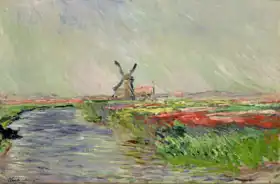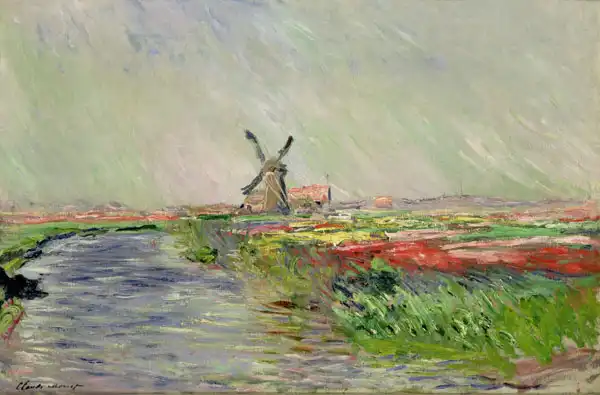About this finishing
Print. The image is printed on the top quality 10-ink HP Z9PS printer on HP matte 270 g / m2 paper. You can choose any size to an accuracy of 1 cm. A margin of 5 cm around the image is added to the size of the motif.


You can find a detailed description about our finishings
here.
Tulip field in the Netherlands
Date:
1886Medium:
oil on canvasLocation:
Musee Marmottan Monet, Paříž, FrancieThe year is 1871.
Claude Monet leaves England with his wife during the Franco-Prussian War. During this time he resides in Zaandan, a picturesque town near Amsterdam. During his stay, he paints 20 views of the city and its surroundings, including fairy-tale mills. Unfortunately, the sky is mostly cloudy, which the author captures using a limited number of colors - copying the style of contemporary Dutch painters. Many years later, in May 1886, the French embassy invites Monet to another visit. Monet spends a whole month traveling the countryside and paints beautiful tulip fields in the process, as an example of another painting with this theme, we can cite
Tulip field with Rijnsburským mill . Compared to the visit in 1871, the weather is favorable, which is also reflected in the vivid and varied choice of colors of the paintings.
Monet painted picture Tulip field in the Netherlands in 1886. Prevailing color of this fine art print is vivid and its shape is landscape. This art piece is located in Musee Marmottan Monet, Paříž, Francie. This image is printed on demand - you can choose material, size and finishing.
Claude Oscar Monet (1840-1926). A native Parisian, who thoroughly developed the idea of
Impressionism. Monet almost scientifically studied the effect of light on different objects. He devoted himself to so called transitory states, which quickly led him to work with colour and light, his paintings acting on the viewer from the first impression. His use of open-air painting and objects which were special only because of light opened the way for the beginnings of modern painting. Monet’s
Impression, Sunrise (1874) not only gave the name to the whole art movement, but secured Monet a place among the best painters of all times. At one time, he resided in London and created his famous study
Houses of Parliament (Monet wondered, How could the English painters paint Parliament when it cannot be seen for the fog?). In the
Giverny, which became his favourite retreat after the death of his wife, he painted motifs from his garden and the popular series
Water Lilies - the world of the water was as poetic and mysterious as a primordial paradise.


